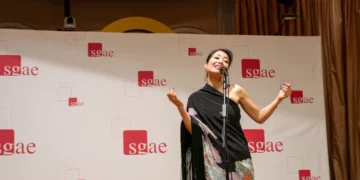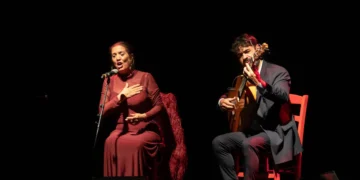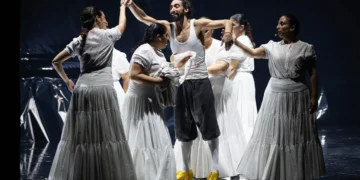|
Dance: Juan Manuel Fernández ‘Farruquito’,
Antonio Fernández ‘Farruco’, Pilar Montoya ‘La
Faraona’, Juan Montoya ‘Barullo’, Antonio Moreno
‘Polito’, Adela Campallo, Keren Jacobi ‘La Hachara’.
Cante: Montse Cortés, Encarna Anillo, José
Valencia, El Canastero, Antonio Zúñiga. Guitar:
Román Vicenti, El Perla. Artista Invitado:
Manuel Molina
And on the seventh day we rested. Thursday the only show
on the festival program was at the Villamarta Theater, but the magnitude
of the individual at the top of the bill made this day the most
anticipated of the entire festival.
But first things first… At the morning press conference the work
“Inmigración” was presented by its author, Fernando
González-Caballos who explained that it is directed to those
foreigners who dream of embarking on a career in flamenco, and pointed
out that Miguel Poveda, the singer who shares the bill with “Inmigración”,
is an immigrant himself. Producer José Carlos Lérida
commented on the social commitment and the need to avoid superficiality,
adding that the show generated more expense than income.

is the festival’s most important draw. Ever since the child
prodigy came of age he’s been surprising audiences the world
over as well as in Spain with his dynamic and original dance which
is, at the same time, rigurously traditional. Manuel Molina opens
the presentation relating the family saga of the Farrucos and sings
a verse which years ago was recorded by the Familia Montoya: “Vamos
a bailar como los gitanos, con luz y color” [‘Let’s
dance like the gypsies, with light and color’], and the line
couldn’t have been more appropriate.
The group is hot. Who says fandango de Huelva isn’t a gitano
dance? With Farruquito and his people this form, usually inoffensive,
turns into a lethal weapon and makes an apt presentation in which
no energy is spared. The audience goes wild with the appearance
of each member of the family, and everyone tries to sort out which
one is which, shouting and applauding with insatiable hunger to
see these astonishing young people.
The show has grown and matured a great deal since its debut in
Mont-de-Marsan last June. Manuel Molina has a bigger role and the
two female dancers, a smaller one, and both changes are positive
in terms of the overall effect. The farruca which Román Vicenti
plays with alternate tuning sounds excellent, but this dance of
Farruquito’s is perhaps the weakest part of the show, no doubt
because it depends more on theatrical movements than on the compás
the dancer manages with such authority, and the red velvet suit
he wears might be what prompted one London critic to call Farruquito
“Spain’s Michael Jackson”.
This isn’t watching dance…it’s
nourishment!…we’re
putting on weight with every passing second.
But as always happens with great artists, Farruquito makes us his
accomplices, we never tire of waiting for his flashes of genius
and absolutely everything is forgiven. The level of his brother
Farruco’s dancing continues to go higher and higher and the
people sitting next to me commented that he has surpassed Farruquito.
But no, the integrity and maturity of the elder dancer, his presence
and his willingness to take risks are qualities not yet matched
in the younger brother.
Among journalists we remark on the difficulty of finding words
to describe the indescribable, when long ago we already ran out
of appropriate adjectives. The rhythmic applause is not reserved
for the end but springs up again and again from the culturally diverse
and totally enthralled audience.

the siguiriya an ingenious touch takes away the collective breath
and provokes a tear here and there. A corpulent figure, possibly
La Faraona dressed in a man’s suit, a hat covering the face,
ascot, cane in hand, slowly crosses the rear of the stage while
Farruquito and friends are raising flamenco hell. It’s old
Farruco! He stops momentarily, glances at the ruckus and continues
on his way. What could have been a corny trick, gives the perfect
touch and reinforces the message of the work: continuity.
This isn’t watching dance…it’s nourishment!…we’re
putting on weight with every passing second, but as happens with
all powerful drugs, instead of becoming satiated, we need more and
more. Manuel Molina provides a sort of epilogue, the fiesta finale
follows, the smallest member of the family comes out to dance, Joselito
Valencia’s cante is to die for, we’re out of breath
and wish it would never end.
Emerging to the world devoid of compás outside the theater
I thought, if the most traditional kind of flamenco, without cajón,
dumbek, nudism, choruses or any other kind of extravagance is capable
of reaching such heights, why aren’t we more demanding? Why
do we settle for the merely pretty when this art, which is bigger
than any artist who practices it, has this perfect and never-ending
built-in dynamic?
Text : Estela
Zatania
|
|
Theater
Villamarta Program
De Peña
en Peña Program: Trasnoches,
De Peñas, Peña de Guardia
Other
shows(Gloria Pura, Bordón
y cuenta nueva, De la Frontera, Café Cantante, Sólos
en Compañía)
Courses
and workshops
Descubre más desde Revista DeFlamenco.com
Suscríbete y recibe las últimas entradas en tu correo electrónico.

























